Double Decker Living Root Bridge: Meghalaya Beauty
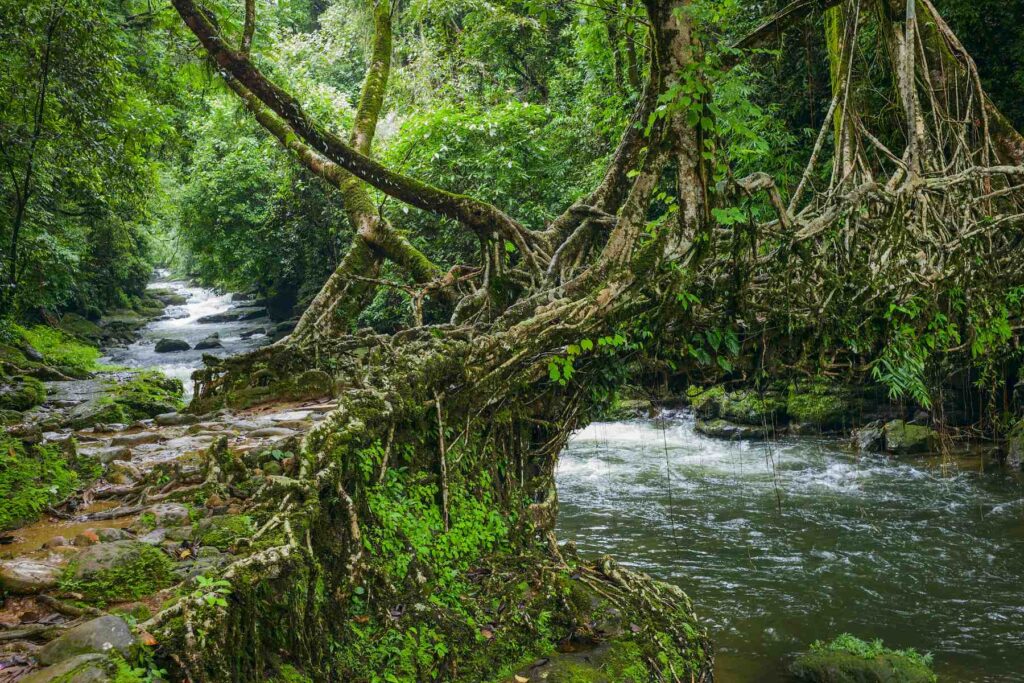
Looking for a place that combines adventure with nature’s beauty? Well, here’s something special – Meghalaya’s Double Decker Living Root Bridge is a beauty. This fantastic bridge, made from ancient tree roots, is a must-see. It has lush greenery and stunning waterfalls around it.
Many Meghalaya tour packages include a visit to this special bridge. It is great for nature lovers and adventure seekers. If you want to visit these stunning suspension bridges in Meghalaya, then TripzyGo travel experts can be your go-to solution. Enjoy your adventure trip in Meghalaya, which is full of thrills and unforgettable memories.
About Double Decker Living Root Bridge
The double-decker living root bridge is a great blend of nature and human ingenuity. It shows a harmonious co-existence with the environment. This unique root bridge of Meghalaya is located in Nongriat village. The process involved guiding the aerial roots of rubber trees over decades. They now form a two-tiered structure. What is so fascinating about these Meghalaya bridges is that they grow over time. They get stronger each year, which helps them withstand the heavy monsoon rains.
A marvel of nature, this wonder gives a spectacular view. It also serves a purpose for the villagers: a safe crossing in bad weather. The dense forests and scenic views on the hike to the site add to the excitement. So, the bridges of Meghalaya are a ‘must-visit’ place.
Suggested read: Laitlum Canyon in Meghalaya: Discover the Stunning Beauty.
Best Time to Visit
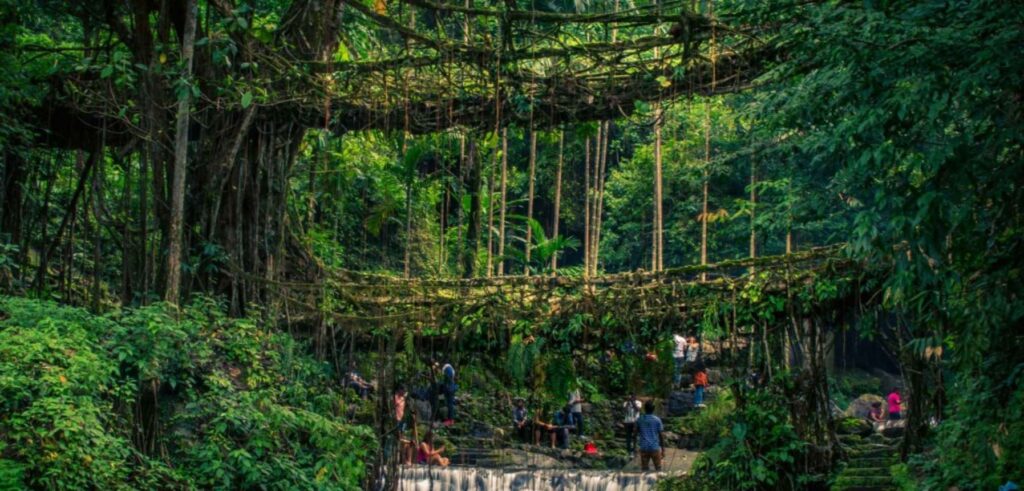
The best time to visit the double-decker living root bridge is during the winter months, October to March. That is when the climatic conditions are fine. We can explore it if it doesn’t rain. The trails become slippery in the dense forests. It is the best time to visit since this season’s surroundings are also lush and green. Do not visit during the monsoon. The rain can make the trails quite slippery as well. If not, plan your visit for the monsoon. The bridge and scenery will be at their best then.
| Did you know? People say the Meghalaya Double Decker living root bridge is over 250 years old. It was initially one root bridge crossing the Umshiang River. However, monsoon rains and floods forced the construction of another bridge. That is how the stunning structure came to be. It is now one of the world’s best examples of nature. |
How to Reach Double Decker Root Bridge
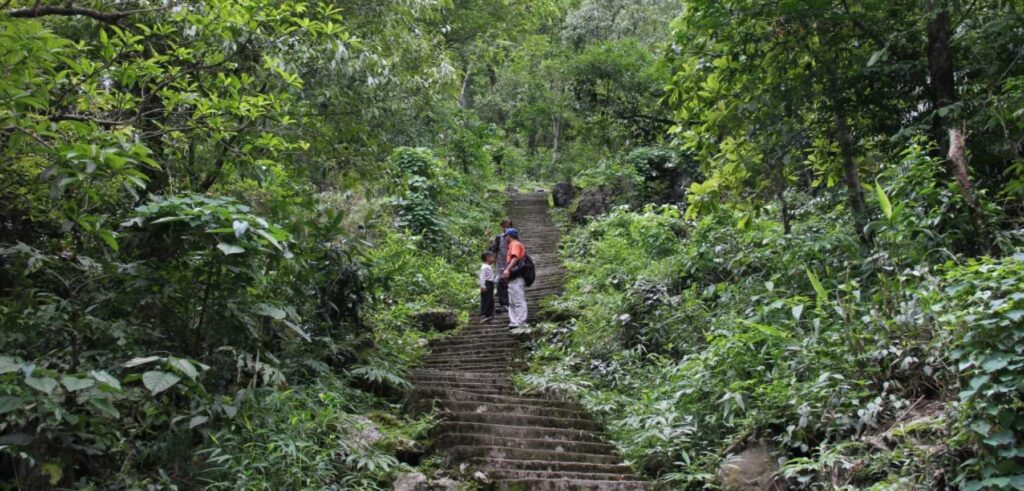
To see the famous double-decker living root bridge in Meghalaya, first, go to Shillong or Cherrapunji. Then, head to Nongriat village, where the bridge is. You will then trek through thick forests and scenic landscapes to a breathtaking structure.
Air
The nearest airport is Shillong Airport (Umroi). It’s 70 km from Cherrapunji. You can continue towards the Decker Living Root Bridge if you take a taxi or bus from the airport to Cherrapunji.
Railway
The nearest railway station is Guwahati, which is 150 km from here. On reaching Guwahati, you can get a bus or a taxi to Cherrapunji. From there, your journey will begin towards the Meghalaya Root Bridge.
Road
Cherrapunji has good road links with Shillong and other towns in the district. You can take a bus or hire a taxi to Cherrapunji. Then, continue to the double-decker living root bridge.
Trek
The double-decker living root bridge is 20 km from Cherrapunji, at Tyrna village. Visitors must descend almost 3,000 steps through a dense forest to reach it. This adventure would thrill them.
Suggested read: Exploring the Serenity of Umiam Lake
Cultural Significance of Double Decker Living Root Bridge
- Unique Construction: The Khasi tribe built the double-decker living root bridge. It is a unique feat of human ingenuity. They make it from rubber tree roots.
- Cultural Heritage: It is integral to the Khasi and Jaintia traditions. This root bridge symbolizes peace and harmonious living with nature.
- Longest Long-Lived Root Bridge: One of the world’s oldest living root bridges. This bridge displays techniques passed down for generations that traditional craftsmen have mastered.
- World Heritage Site: This bridge awaits a UNESCO listing. It shows the site’s ecological and architectural value.
- Living Legacy: This unique structure will educate future generations on eco-friendly practices. They are vital to the Khasis’ culture and environment.
Suggested read: Nohkalikai Waterfalls: Meghalaya’s Tragic Beauty
Things to Do at Double Decker Root Bridge in Meghalaya
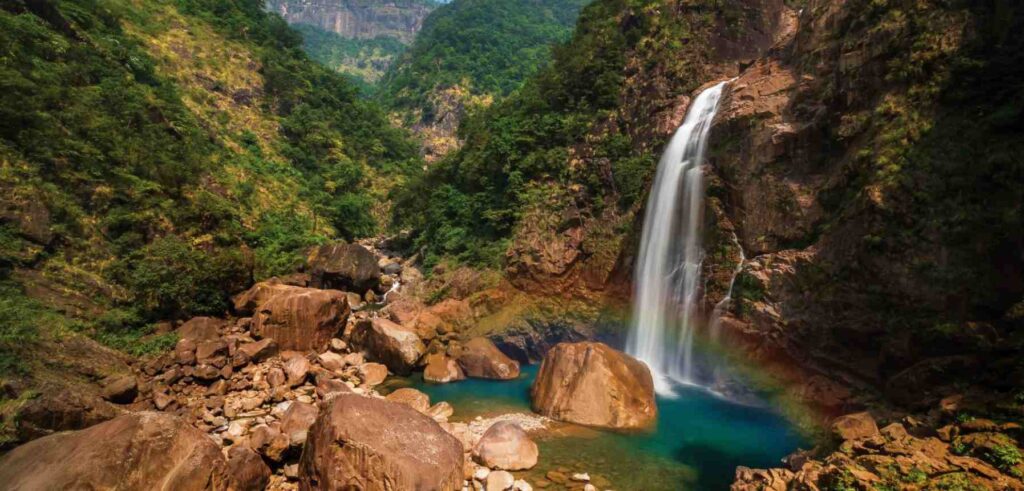
The double-decker living root bridge is the main draw. But there is even more amazing stuff around Nongriat. Here are six more beautiful places to visit. They are after you see the famous double-decker, living root bridge.
Rainbow Falls
Rainbow Falls is an hour’s walk from a stunning, double-decker, living root bridge. It is exceptional. It plunges into a pool of crystal-clear water. On sunny days, one can see it surrounded by an exquisite rainbow in the mist, seeming almost magical.
Tyrna Village
It’s a great base for a walk through the green to the double-decker living root bridge. One can stroll or get friendly with the locals, who are part of the Khasi tribe.
The Single Living Root Bridge
First, you pass through a single root bridge. Then, you reach the double-decker living root bridge. The smaller yet equally interesting natural creation deserves a break to appreciate.
Mawsmai Cave
A few kilometres from Nongriat, it is a beautiful limestone cave with formations and winding passages. These will delight adventure-seeking tourists.
Cherrapunji Viewpoints
Visit a few breathtaking viewpoints in Cherrapunji. They offer panoramic views of hills, valleys, and waterfalls.
Nohkalikai Falls
Just a drive away is Nohkalikai Falls, reputed to be the tallest plunge waterfall in India. It is a must-visit for nature lovers, with dramatic drops and mist all around.
Suggested read: Nohkalikai Waterfalls: Meghalaya’s Tragic Beauty
Things to Keep in Mind
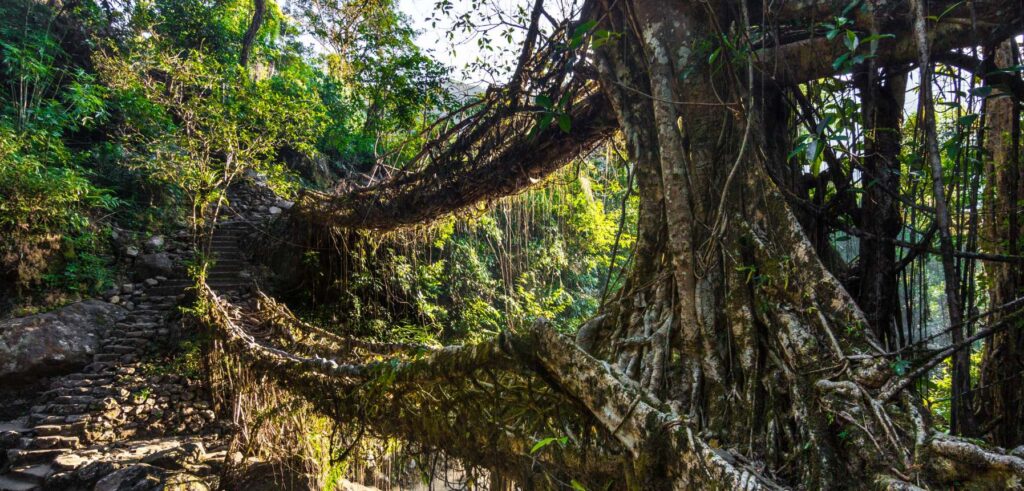
- Physical Fitness: The double-decker living root bridge has over 3,000 steps. So, one must be fit to climb them.
- Carry Water: One must carry water. The hike could be grueling, especially in the rainy season.
- Boots: You need strong boots with a good grip. The steps to the double-decker living root bridge need to be more balanced.
- Pack Light: Carry only the essentials. Bring water, snacks, and a small first-aid kit to avoid fatigue.
- Respect Nature: One should never litter. Be aware of the local environment.
- Timing: Start early in the day to complete the trek and return before dusk.
- Local Guidance: Find tips for exploring the trails and the area’s culture and history.
Suggested read: Best Places to Visit in Meghalaya
Must Visit Destination: Double Decker Living Root Bridge
The double decker living root bridge is a natural wonder. Every visitor to Meghalaya would remember it. This trek, in pursuit of adventure, scenery, or even cultural experience, leaves one awed at the marvels of nature. The landscapes are stunning, the bridge is unique, and the locals are friendly. So, this is a must-stop on any Meghalaya tour. It is a wonder of fusion between man and nature: the living double-decked root bridge. If you have a Northeast trip planned, do pay a visit.

